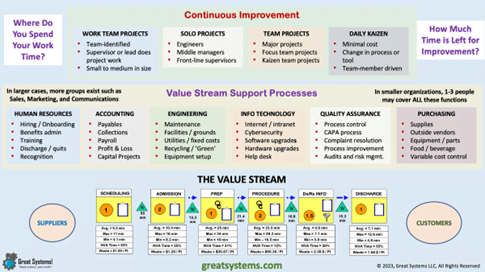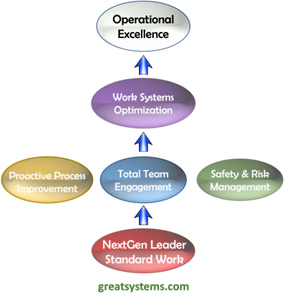The 5 Essentials of Operational Excellence
Mar 31, 2023
A Confusing Start to My Own Operational Excellence Pursuit
Officially, I began my operational excellence pursuit almost 45 years ago. However, I did not know it at the time. Between 1985 and 1990, I was at work in my first true operational excellence workplace. My first two employers were traditional manufacturers. This third site was different.
From that point forward, my goal has been to help companies pursue operational excellence. At the same time, as a small business owner, I pursue it myself. My work studies and experiences with over 100 top performers, some up close, have taught me how these workplaces somehow manage to sustain what so many cannot.
Previously, when one would ask what I did for a living, I would say “I help leaders use proven work system designs to get better results.” Sure, whatever that means. If you understand organizational ergonomics, the first sentence makes sense. Most people favor the second sentence, and I could sense their confusion.
For the past thirty years, I have worked to find a better way to explain HOW the best organizations achieve and sustain operational excellence. In my 2006 book about high performance work cultures, I made use of ten key work systems as a model. That was too much. Then, I came up with a five-point path for process excellence pursuit in my 2015 workbook. Still, there was a lack of meaningful resonation.
How do you pursue operational excellence? If asked, what changes do you suggest people make in order to improve performance? My goal with this post is to provide a clear path for such a course.
What Truly Constrains Operational Excellence
After many years and daily thought, the Industrial Engineer inside of me finally found their voice. What that voice told me was this. It is not primarily about work system design. Work systems are difficult to see on the job. They are tough to describe. Plus, so many people share the use of most work systems. Fortunately, how we spend time daily is much more visible.
Focus first on the value streams and the processes that provide value stream support. Then, see how much job time is left for improvement-type activities. Such activities include research and development, training, preventive maintenance, and process improvement.
When one looks at work this way, it is easy to see why we have operational excellence struggles. After we take care of our value streams each day, little time remains for ANY improvement-type activities. Continuous process improvement is only one item on the list (Figure 1).

OPEX Essential Nr. 1: NextGen Leader Standard Work
With a focus on time in mind, I began to rethink the model. Hourly staff rarely have more than 5% of their job time that can go towards improvement-type activities. This is roughly 100 hours per year. In most organizations, any ‘away from the job’ time typically goes to required training. By itself, the typical 40-50 annual training hours per person requirement can use up 50% of their available improvement time.
In turn, leaders must drive operational excellence. However, how many leaders have job descriptions that clearly define such expectations? How many expected tasks receive their requisite improvement time allocation? Very few, in my experience. This is my prime revelation! To sustain operational excellence, we must both define Leader Standard Work and provide adequate amounts of such support. From an industrial engineering perspective, the time utilization math makes sense.
That is the first essential of operational excellence. Define time for improvement via a new form of Leader Standard Work. Some organizations actually have blueprints to help do this. If we can’t eliminate leader standard waste to increase available improvement time, we won’t have time for the other essentials. Proactive process improvement, total team engagement, and effective safety and risk management all require time that few leaders have enough of in their current job designs (Figure 2).
What Do You Mean – NextGen Leader Standard Work
Multiple factors and trends indicate that today’s prevailing leadership practices are ineffective. Research done by Gallup via the use of their Q12 survey indicates a significant disconnect between what people want and what leaders think they want. Engagement levels have been below 50% for decades. Now, stress levels are nearing that percentile.
The Great Resignation in 2020-2021 resulted in at least 30-40% workforce turnover in many organizations. Even prior to the Pandemic, Gen Z leaders such as David Hogg and Greta Thunberg were advocates for new capitalism and leadership approaches.
Ironically, what they ask for is little different than what workforces have wanted for decades. More involvement in decision making, a great say in their future, and more equitable treatment and compensation lead the list.
Such factors are typical in operationally excellent organizations. However, we must invest significant leader time to get there.
OPEX Essential Nr. 2: Address Essential Safety, Health, Environment, and Security Needs First
Proactive process improvement and effective safety and risk management are part of any effective operational excellence pursuit. However, to do them well, leaders need time away from the value stream. Too much work exists to simply ask leaders to ‘find time’ for these new tasks. They try, but efforts fade with fatigue, and often, a lack of support.
Naturally, we begin with safety and risk management. We want to effectively cover the basics, but we don’t want to use too much of our available improvement time. The best approach is to use front-line leader standard work every day to reinforce safety, health, environment, and risk expectations and practices. In other words, make it a form of team engagement that leaders perform as a daily work habit.
Some support group improvement time is needed as well for this essential. Safety Committee work, security and safety audits, and other forms of process support require time resources just as any of other form of improvement. Leaders need to ensure they meet key priorities in these areas first.
OPEX Essential Nr. 3: Process-based Improvement Comes Before Project-based Improvement
Proactive process improvement should be your next target. Done correctly, when we attack errors and defects at the process source before they become major problems, it creates more time for improvement. As we reduce complaints, downtime, rework, and waste levels, costs go down. We can re-invest some of this savings in improvement time.
The challenge is this. We can’t approach process improvement in only a project by project manner. It simply takes too long. Instead, every process owner must practice proactive process improvement DAILY as part of their leader standard work. Every process owner must consistently reduce existing leader standard and process time waste to create improvement time.
Eliminate email, text, and meeting waste to provide time for process analysis. Leaders need time to capture and analyze key transaction costs, counts, and problems every day. Require each process owner to spend time with their team in a search for innovative solutions. Know your problems, know your costs, and know your options for future gains.
OPEX Essential Nr. 4: Total Team Engagement Sells the ‘Compelling Why’ for Work Habits Change
Today’s workforce is more diverse than many leaders expect. Such diversity requires an equivalent variety in how we engage our staff. Some people want to be on project teams or recognition committees. Others prefer to engage through social media on the company’s intranet site. Fortunately, technology provides us with many engagement paths your staff can use on a consistent basis.
Primarily, the process work team serves as the team engagement focal point. In smaller organizations, project teams are not realistic given the small total staff size. Still, leaders can empower their process work teams to identify and make improvements. They can help them continue to learn. Most importantly, when you couple effective process work team engagement with proactive change at the process level, the benefits are synergistic.
Total team engagement, done well, requires the most ‘away from the stream’ time. Typically, people need to develop both their soft and hard team skills. In turn, we add in the project and focus team system components after we have made gains with the process work teams. Teams experience more engagement than in the past as proactive improvement occurs, but not as much as they will once the full engagement plan is in effect.
OPEX Essential Nr. 5: Work Systems Optimization Smashes Silos
When we optimize work system design, silos disappear. Plus, we turn over the routine work to the bots – even the cognitive stuff. A value stream focus promotes optimization much more than a department focus. Also, the use of a balanced, and aligned, set of key performance indicators across ALL work processes promotes the same. Digitalization ties it all together, as it makes it easier for all staff to share and analyze data.
Geolocation, geozones, and information tags enable workflow monitoring and improvements. Plus, the Internet of Things (IoT) ties all of these lean data capture efforts together. This integration of information gives us a more realistic picture of human and equipment asset optimization. When people get the right data push at the right time, decisions are made more easily.
Finally, artificial intelligence can learn from the new, enhanced datasets at a faster rate than humans. Humans must exist to make higher level, and final, decisions. However, AI helps significantly optimize the use of leader time. In short, digitalization helps make leader standard waste, and other forms of process waste, more visible. If we can see our waste, we are much more likely to eliminate it with process changes.
The Five Essentials are Themselves a Process
Too many organizations either pick and choose their improvement options or take shortcuts. It’s easy to ask people to change and criticize them when they fail. Neither approach will help you sustain operational excellence.
If one wants different results, they must change the design of the work systems that produce their current outcomes. They must change how time is spent at work each day. Everyone must develop new daily work habits. Time for improvement cannot be bought. Instead, it’s only source is the elimination of process waste.
It all starts with a new definition for NextGen Leader Standard Work. To move towards, let alone sustain, operational excellence, every leader must shift how they spend their daily work time. Blueprint templates exist, but senior leaders must decide how they want to align their daily work habits with the organization’s mission, vision, values, and strategy.
Plus, we must give our leaders easy-to-use feedback systems to help them consistently hold themselves accountable for daily time expenditure. Finally, we must expect all leaders to use improvement tools daily and teach tool use to their team.
Fortunately, significant momentum builds as one works through these five essentials. As we gain momentum, time becomes available to improve more things. This takes away current process headaches and helps increase morale. The end result is the translation of more value to both our internal and external customers.
Yes, the pursuit of operational excellence is itself a process. Would you expect anything else? Keep improving!
References
“How the Great Resignation is turning into the Great Reshuffle,” Alex Christian, 14 December 2021, BBC.com
“State of the Global Workplace 2022 Report – the Voice of the World’s Employees,” Gallup Inc., 2022
“A new look at how turmoil is defining the lives and politics of Generation Z,” Juana Summers, National Public Radio, January 18, 2022
About the Author
Kevin McManus is the Chief Excellence Officer of Great Systems LLC. He provides virtual coaching and content to help people use proven best practices to make work a better place. Over forty years of work experience in roles such as Industrial Engineer, Training Manager, Production Manager, Plant Manager, and Director of Quality give Kevin a ‘real life work’ perspective relative to daily work process optimization, work team engagement, proactive process improvement, and sustainable operational excellence.
You can find and connect with Kevin on LinkedIn.
Original Article: https://opexsociety.org/body-of-knowledge/the-5-essentials-of-operational-excellence/
Stay In Touch.
Subscribe to our newsletter and exclusive Leadership content.


